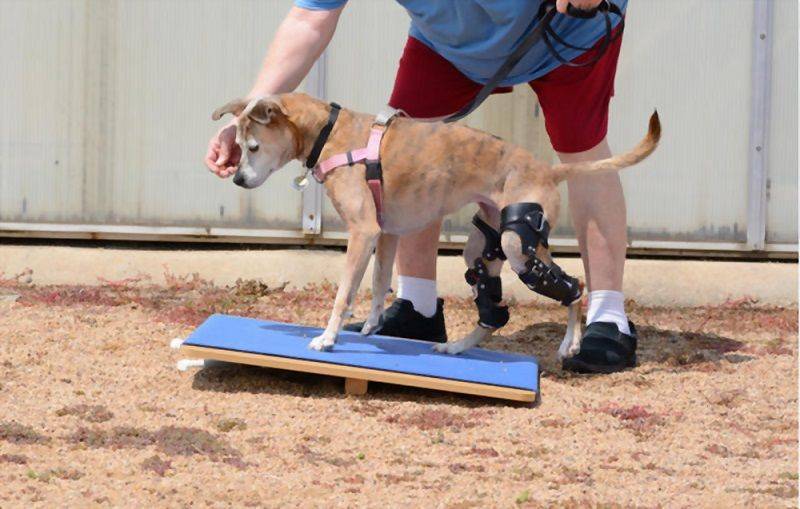For dogs, knee injuries are one of the most common problems they will encounter in the span of their lives. But it doesn’t have to be that way! With proper precautions, sufficient support, and noble know-how you can help keep your pooch from experiencing the worst knee injuries can offer.
How to Prevent Canine Knee Injuries

There are several different knee injuries or conditions that can afflict your pooch. Patellar luxation (when the kneecap dislocates) is one, tearing or spraining the cranial cruciate ligament (CCL) is another. Here’s what you need to know to be proactive in your pet’s knee health.
Know Your Pet’s Risk Factors
There are a number of risk factors to be aware of when it comes to your pet. Some of them are unique to their specific situation, so do an honest assessment to better understand and plan for your dog’s health.
Age
Dogs young and old are at risk for certain knee injuries. As dogs age, their ligaments can be worn down making them susceptible to injury. When they are younger they are rapidly growing and their joints may not be as stable as they should be, allowing for dislocations and tears.
Weight
Obesity is a huge problem for pets across the country. Aside from the other host of health concerns, overweight dogs put a much heavier burden on their joints. Those ligaments are evolved to support that breed at their natural weights, not with an extra dozen (or more) pounds.
Breed
Breed plays a huge role in the overall health and potential for injuries in any dog. When it comes to knee injuries, large dog breeds including Rottweiler, Newfoundland, Staffordshire Terrier, Mastiff, Akita, Saint Bernard, Chesapeake Bay Retriever, and Labrador Retriever are all more susceptible. The combination of weight, energy levels, and their rapid growth when young can make a recipe for injury.
Spayed/Neutered
Whether or not your dog is still intact can also have some say on the health of their knees. Testosterone and estrogen play a huge role in the health of various tissues in the body including the ligaments. When a dog is spayed or neutered their ability to produce those hormones dwindles leaving the ligaments without that helpful chemical and becoming less elastic.
Previous Injuries
Dogs who have had a previous knee injury are more likely to experience another. When it comes to CCL tears, for instance, it is incredibly common for dogs who have a tear in one knee to develop complications in their other leg as they try to compensate for the wound. Patellar luxation is another complication that can increase the odds of further injury.
Unique Circumstances
Does your home have a lot of stairs? Does your dog jump on the couch and bed? These might not seem like risks, but they present opportunities for injuries to occur. Stairs can be rough on the joints, especially if your dog takes them at speed or falls.
Any one of these risk factors is enough to note, but often there isn’t just one. It’s the combination of several that can lead to injury. So recognize, accommodate, and adjust for them. Be proactive in eliminating those you can, and working to decrease those you can’t.
Healthy Diet, Good Exercise
ne of the biggest risk factors for knee injuries is obesity and generally poor health. Unlike breed, however, this is entirely within our control! Provide your dog with a healthy diet, feeding them quality food that meets their dietary needs. Most foods don’t include the necessary compounds for joint health so provide a supplement rich in glucosamine, chondroitin, and MSM.
Now, not all exercise is good exercise. You wouldn’t ask a child to bench press 300 lbs! In the same way, you need to customize your dog’s workout for them. A good, proper workout for a young pup might be too much for an older dog. For older dogs stick to walking as a great, low impact exercise. If your dog knows how, swimming can be an excellent exercise for all ages (though not all breeds). To find out more check the AKC’s guide on exercising senior dogs.
Support with a Dog Knee Brace
We have covered the benefits of braces before but it bears repeating here. Many knee injuries are related to the weakening or partial tearing of the ligaments inside the knee, like their CCL. With these ligaments weakened, the knee (and the dog’s leg as a whole) loses the stability it requires to function correctly. The potential for further injury is likely.
These braces made of soft, stretchable neoprene that provide outside support to the knee joint, keeping everything in place. When dogs experience an injury to their CCL it may not be a complete tear necessitating surgery – but if left unchecked it certainly can get worse. Use a dog knee brace to provide your pet with the joint support they require.
Preventing injuries as best you can save your dog a whole lot of pain, not to mention yourself some vet bills. Practicing these prevention tips will put you and your dog in a stronger, better place to recover should an accident happen.
